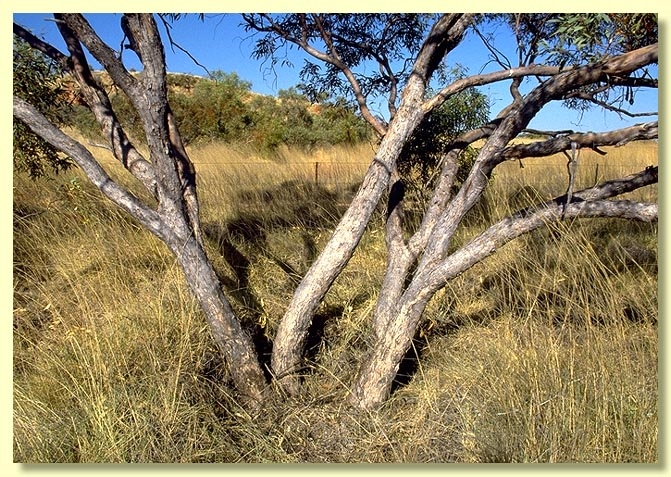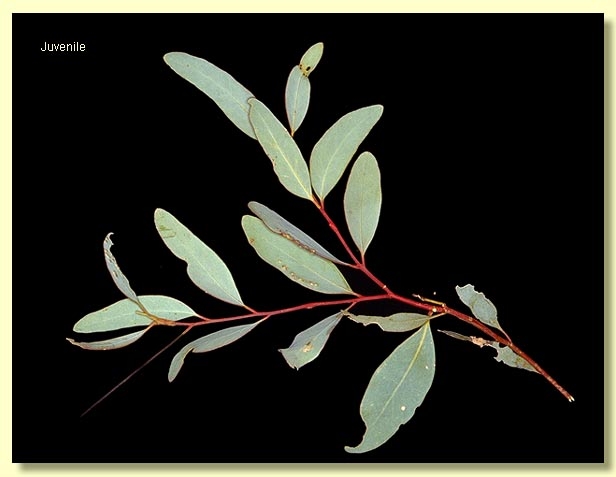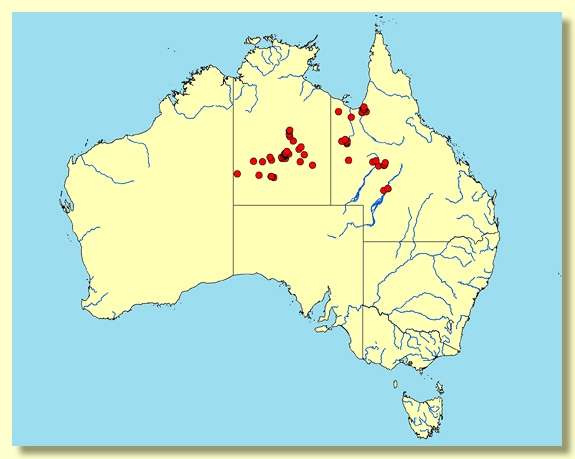Eucalyptus | Symphyomyrtus | Adnataria | Apicales | Buxeales | Amissae
Euclid - Online edition
Eucalyptus normantonensis
Eucalyptus normantonensis Maiden & Cambage, J. & Proc. Roy. Soc. New South Wales 52: 489 (1919).
T: Normanton, Queensland, Aug. 1913, R.H.Cambage 3930; holo: NSW; iso: BRI.
Eucalyptus bicolor var. xanthophylla Blakely, Key Eucalypts 232 (1934); E. largiflorens var. xanthophylla (Blakely) Cameron, Victorian Naturalist 63: 42 (1946). T: Camooweal, Qld., 26 June 1922, S.A.White s.n.; syn: n.v.; Barrow Creek N.T., 3 May 1922, S.A.White 244; syn: NSW; isosyn: AD.
Mallee to 5 m tall, rarely a small tree to 8m. Forming a lignotuber.
Bark rough and flaky, grey-brown, box-type, extending over part or all of stems, smooth above dark brown to grey-brown.
Branchlets lack oil glands in the pith; not glaucous.
Juvenile growth (coppice or field seedlings to 50 cm): stems square or rounded in cross-section; juvenile leaves always petiolate, opposite for 1 or 2 pairs then alternate, elliptical to lanceolate, 4–9.5 cm long, 1.2–4 cm wide, dull, grey-green to green.
Adult leaves alternate, petioles 0.8–2.2 cm long; blade lanceolate to falcate, 5–11(15.7) cm long, 0.7–2(3.2) cm wide, base tapering to petiole, margin entire, apex finely pointed, concolorous, dull at first, green to grey-green but maturing glossy, green, side-veins acute to slightly greater than 45° to midrib, reticulation dense to very dense, intramarginal vein present, oil glands mostly intersectional, sometimes sparse.
Inflorescence terminal compound, sometimes with a few solitary axillary also, peduncles slender, 0.3–2 cm long, buds 7, 9 and 11 per umbel, pedicels 0.1–0.6 cm long. Mature buds obovoid to ovoid, (0.2)0.3–0.4 cm long, 0.2–0.3 cm wide, scar present (outer operculum shed early), operculum bluntly conical to rounded, sometimes apiculate, stamens inflexed or irregularly flexed, outer stamens without anthers (staminodes), anthers ± adnate (filament apex tapers slightly), basifixed, cuboid to globoid, dehiscing by lateral slits, style long and straight, stigma blunt to tapering, locules 3 or 4, the placentae each with 4 vertical ovule rows. Flowers white.
Fruit on pedicels 0-0.5 cm long or rarely sessile, shortly cylindrical to barrel-shaped or truncate-globose, (0.25)0.3–0.5 cm long, 0.3–0.4 cm wide, disc descending vertically, valves 3 or 4, usually enclosed, sometimes at rim level.
Seeds dark brown, 0.8–1.5 mm long, flattened-ovoid, sometimes pointed at one end, dorsal surface shallowly reticulate, hilum ventral.
Cultivated seedlings (measured at ca node 10): cotyledons small, reniform; stems usually square in cross-section; leaves always petiolate (petioles to 0.7 cm), opposite for 5 to 10 nodes then becoming alternate, lanceolate, 4.5–11 cm long, 0.8–2.4 cm long, base tapering to petiole, apex pointed or blunt, dull, green to blue-green or grey-green.
Flowering has been recorded in January, February, March, May, June, July, August and October.
Usually a mallee, found at widely dispersed localities in Western Australia, the Northern Territory and Queensland, extending from the hot, arid Pollock Hills region of Western Australia, across the Western Australian–Northern Territory border into the Kintore Range area west of Alice Springs, to the Normanton area in the south-eastern hinterland of the Gulf of Carpentaria with its hot monsoonal climate, wet in summer followed by a long dry period. It is found on stony plains and on rocky hills and plateaus. It is recognised by its rough stocking of box bark with the upper bark smooth and often chocolate brown, leaves dull becoming glossy green, and flowers with infertile outer stamens.
Eucalyptus normantonensis belongs in Eucalyptus subgenus Symphyomyrtus section Adnataria (the boxes) because the buds have two opercula, ovules are in four rows, seeds are flattened-ovoid, cotyledons are reniform, and anthers are rigid on the staminal filaments. Within section Adnataria, E. normantonensis is part of a subgroup, series Buxeales, further distinguished by being partially rough-barked, having terminal inflorescences and buds that lose the outer operculum early. Within this widespread group this species is probably closest to E. lucasii from arid Western Australia, but, compared to that species, E. normantonensis has more extensive rough bark, darker smooth bark and smaller fruit. In the east of the geographic range of E. normantonensis another box species found in hills in the south-east Gulf country of Queensland, E. provecta, differs from E. normantonensis in having rough bark to the small branches and outer stamens that are infertile (staminodes).
Eucalyptus normantonensis: named after the town Normanton, where the type specimen was collected.
















